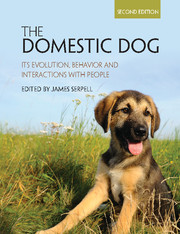Book contents
- Frontmatter
- Dedication
- Contents
- List of contributors
- 1 Introduction
- PART I ORIGINS AND EVOLUTION
- PART II BEHAVIOR, COGNITION AND TRAINING
- 5 Genetics of dog behavior
- 6 Becoming a dog: Early experience and the development of behavior
- 7 Breed and gender differences in dog behavior
- 8 Dog social behavior and communication
- 9 Ethology, ecology and epidemiology of canine aggression
- 10 Social cognition and emotions underlying dog behavior
- 11 The learning dog: A discussion of training methods
- 12 Dogs in today's society: The role of applied animal behavior
- PART III DOG-HUMAN INTERACTIONS
- PART IV LIFE ON THE MARGINS
- Index
- Plate section
- References
12 - Dogs in today's society: The role of applied animal behavior
from PART II - BEHAVIOR, COGNITION AND TRAINING
Published online by Cambridge University Press: 30 December 2016
- Frontmatter
- Dedication
- Contents
- List of contributors
- 1 Introduction
- PART I ORIGINS AND EVOLUTION
- PART II BEHAVIOR, COGNITION AND TRAINING
- 5 Genetics of dog behavior
- 6 Becoming a dog: Early experience and the development of behavior
- 7 Breed and gender differences in dog behavior
- 8 Dog social behavior and communication
- 9 Ethology, ecology and epidemiology of canine aggression
- 10 Social cognition and emotions underlying dog behavior
- 11 The learning dog: A discussion of training methods
- 12 Dogs in today's society: The role of applied animal behavior
- PART III DOG-HUMAN INTERACTIONS
- PART IV LIFE ON THE MARGINS
- Index
- Plate section
- References
Summary
Introduction
It is likely that humans practiced applied animal behavior long before the development of formal studies of animal behavior. Hunters, herders and other early peoples depended on the careful observation of animal behavior and engaged in a wide range of practices to manage the animals in their care. Chief among these animals were the dogs that played so many different roles in human culture, as illustrated in this text's multiple chapters. In most cases, however, dogs in developed countries are no longer employed in their historic roles. When Americans are asked why they have a dog, a significant number respond that companionship is a primary reason (American Pet Products Association (APPA), 2012). Dogs are extremely popular; one-third of all American households have at least one. The estimated number of American pet dogs totals approximately 78 million (APPA, 2012), and similar rates of dog ownership have been reported elsewhere in the developed world (Dog News, 2011). This companionship between people and their dogs supports a substantial multibillion-dollar industry consisting of food, toys, equipment and pet-related services (Veterinary Practice News, 2010). Despite these investments, and the good intentions of dog owners, many millions of dogs suffer poor welfare, or end up homeless or relinquished to animal shelters each year. Applied animal behavior can play an important role in supporting the human–dog relationship and improving the lives of both pets and the people who own them.
The development of applied animal behavior
In many ways, the formal study of animal behavior can be traced to Charles Darwin and The Expression of the Emotions in Man and Animals (1965 [1872]). He was eventually followed by George Romanes (1970 [1881]) and many others. Important contributions to our understanding of learning in animals came from Ivan Pavlov (1927) and Edward Thorndike (1913). Pavlov's description of classical conditioning and Thorndike's elucidation of the “Law of Effect” and what we now call “instrumental conditioning” provided critical theoretical underpinnings for many of the interventions employed in applied animal behavior (Reid, 1996). John Watson (1959) and B. F. Skinner (1938) greatly expanded our understanding of instrumental conditioning, leading to the development of ever more sophisticated methods for influencing behavior. Much of this research was conducted in laboratories and was restricted to relatively few species, leading to some concern that the broader understanding of the underlying processes might be compromised (Beach, 1950).
- Type
- Chapter
- Information
- The Domestic DogIts Evolution, Behavior and Interactions with People, pp. 227 - 244Publisher: Cambridge University PressPrint publication year: 2016
References
- 2
- Cited by



